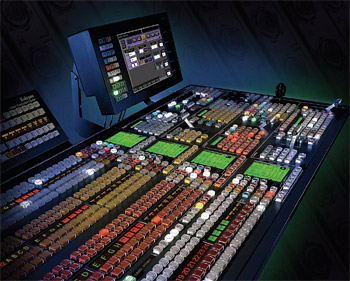What Goes into Buying a New Switcher?
JOHNSTON, IOWA
A couple of years ago when Iowa Public Television decided to produce virtually everything in HD, we designed our core infrastructure as a single layer of HD video routing, switching and processing. In our view, from the technical side, this made for a much simpler plant design that was easier to understand, work in and maintain than a more complex multilayer plant with SD and HD levels as well as file based layers. In essence, we wanted to avoid creating a cloud within the confines of the IPTV facility which we sent things into and hoped that what we wanted came out.

Grass Valley KalypsoDECISION TREE
As an example of our decision process, I'd like to look at our selection of production switchers, what we ended up with and how, now a few years down the road that decision has panned out. The first go/no-go decision was pretty easy—we analyzed our production workflow for the type of content we create and then looked at all of the possible choices out there and asked the question: Does this product work in that environment? If the answer was yes it went to the next round. The next question was: Does this product really work? Much of that evaluation was based on numerous visits with manufacturers at NAB, SMPTE and other shows and asking for demonstrations of specific required features or processes.
Typically we were told that a required feature wasn't available yet but would be in the near future if we would wait one more cycle (typically six months). If it wasn't available by then, the product was a no-go and pulled from consideration. I had a few manufacturers complain that we weren't providing them with enough time but I expect the delivered product to do everything that was promised. As part of that process, the IPTV team also had to reconfirm that the feature was a "must have." If not, it was pulled from the requirements so that all of the manufacturers had equal opportunity.
'SOFT AND FUZZY'
Through this decision tree process we got down to four production switchers which met all of the requirements so that from the purely technical viewpoint, we knew that any of the products would work in our environment. This is where the digital decision tree ended and the "softer and fuzzier" decision process begins. This involved bringing in all four of the switchers for week-long setup and demonstrations and having technical directors, producers and engineers go through the systems, try them out and rate them based on more subjective qualities.
I am an engineer that looks at the creation of content as a combination of technology and art. So I look at the technology—in this case the production switcher—the same way a musician looks at an instrument. Most musicians that can play a specific instrument will tell you that they can play any make or model of the instrument but they have their favorite makes and models and even specific units within the model. If you ask for explanations as to why, you'll hear terms that are hard to quantify, like "feel" and "tone" and "warmth." It really is an emotional response, not a technical response.
I hear similar things when I talk with technical directors at IPTV and other facilities that I have been associated with. As their skill level increases, they become much more aware of and in tune with very subtle factors that make one instrument more pleasing to play than another, even when talking about switchers. It was this level of evaluation that led IPTV to ultimately select the Grass Valley Group Kalypso switcher for our HD production control room.
The Kalypso has been in service for about three years and the question is, are we still happy with the selection? I am pleased to say that the answer to that question is yes. From the technical side, the system has performed very well. There were a couple of early infantile failures like power supplies and bad switches, but nothing fundamental to the long term performance of the system.
Anyone who watched the Iowa Caucuses during the 2008 elections saw this switcher in operation since that event originates from the IPTV studios. If there are any complaints regarding the switcher's capabilities it may be that we underestimate the capabilities of the unit and find ourselves in some ways underutilizing it. The only negative comment I will make is that I made a technical decision regarding the switcher's stillstore capability that turned out to be wrong. Whereas the Kalypso has a pretty good capacity for functioning as a stillstore, in our environment, the methodology for inputting stills into the unit was too cumbersome. Our technical directors raised the issue before we purchased the unit; I asked them to try, they did, and then we all agreed that although the capability was there, it didn't meet our needs so we ended up purchasing a stillstore which did.
My advice when buying instruments for your orchestra is to work closely with the people that will be playing them because even if you can't tell the difference, they can.
Bill Hayes is the director of engineering for Iowa Public Television.
The professional video industry's #1 source for news, trends and product and tech information. Sign up below.
Bill Hayes is the former director of engineering and technology for Iowa PBS and has been at the forefront of broadcast TV technology for more than 40 years. He’s a former president of IEEE’s Broadcast Technology Society, is a Partnership Board Member of the International Broadcasting Convention (IBC) and has contributed extensively to SMPTE and ATSC. He is a recipient of Future's 2021 Tech Leadership Award and SMPTE Fellow.

